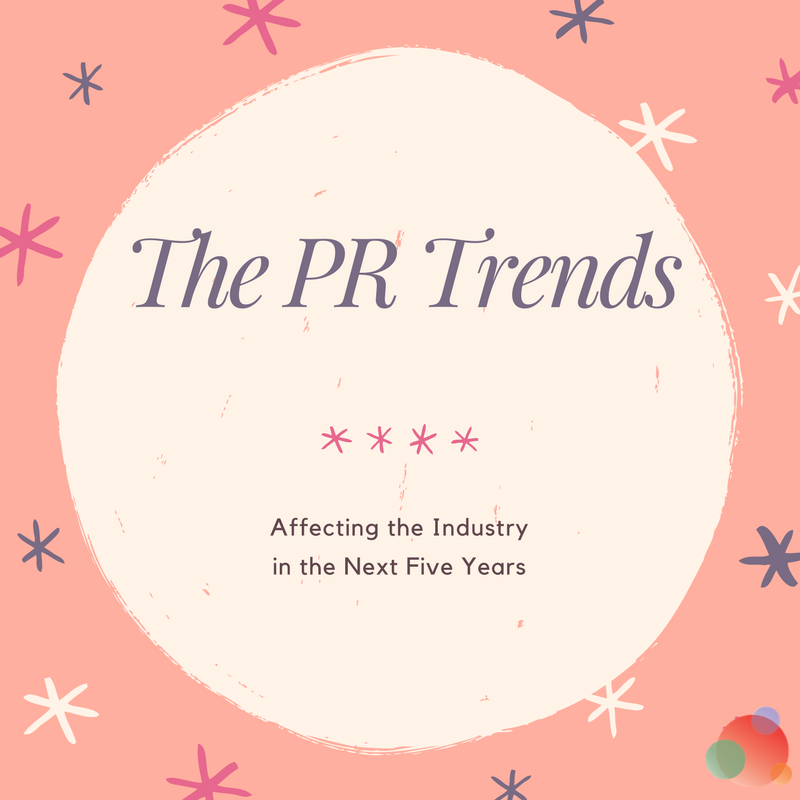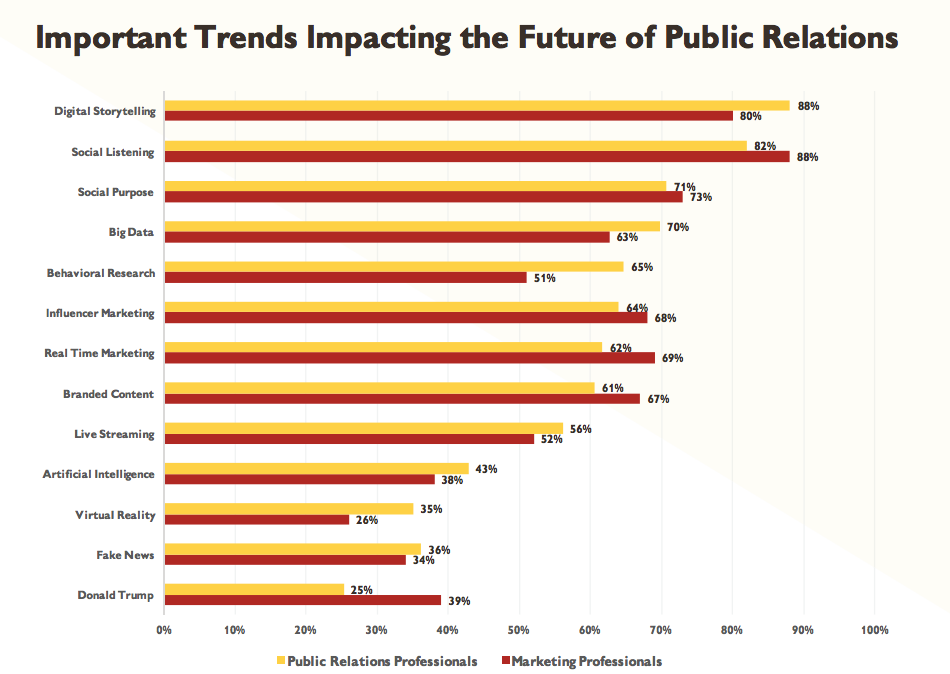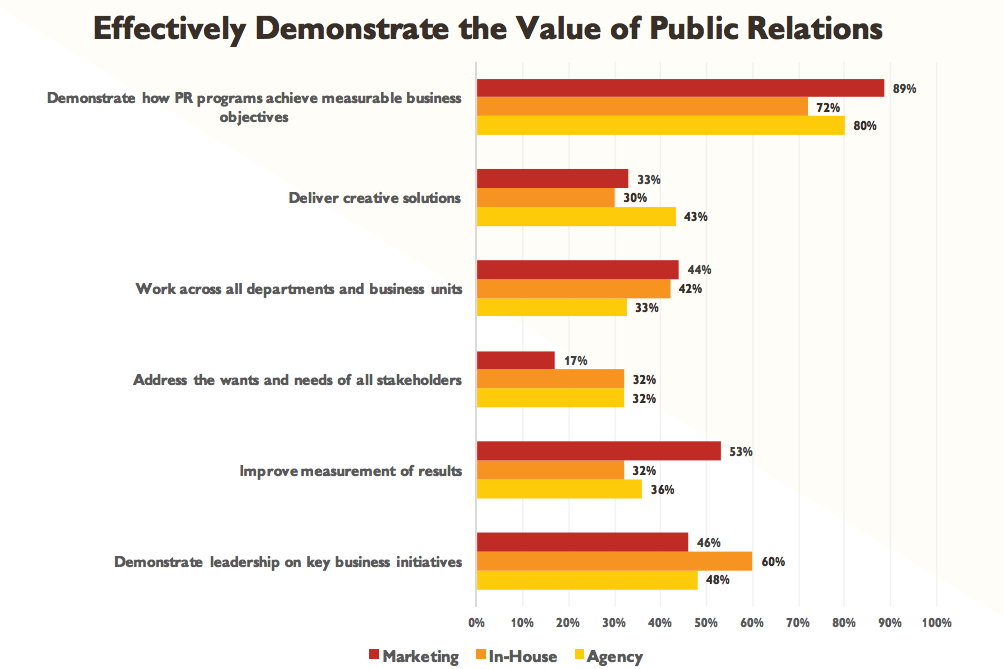 As we think about the next five years, there are many PR trends that affect the decisions we make right now.
As we think about the next five years, there are many PR trends that affect the decisions we make right now.
Will artificial intelligence really take our jobs?
Can virtual reality supersede some of the things we do?
Are fake news, #alternativefacts, and the general public’s perception of the White House press staff going to eventually kill us?
Though confidence in paid media continues to decline, the trend shows organizations spending more and more money there.
Does that mean branded content and influencer relations programs will reign supreme in our day-to-day lives?
As organizations bring more of their public relations in-house (62 percent, according to an Association of National Advertisers survey), will agencies become defunct?
Currently, 18 percent of corporate communications departments report into marketing.
If that number grows, will their influence decrease?
Currently, PR agencies report into marketing 21 percent of the time.
If that number grows will the bottom lines of agencies decrease?
As a business owner, these are the types of things that keep me awake at night.
Buh-Bye Earned Media
It’s no surprise that the value of earned media has decreased significantly since 2009.
I have a friend who was my go-to guy at the Wall Street Journal.
In 2010, he called to say he’d be in town and invited me to breakfast.
I’ll never forget sitting across from him, enjoying my French omelette, when he told me he’d been furloughed.
He was optimistic it was a temporary thing and he’d be back at work in 30 days.
It was not a temporary thing.
He now is an aspiring novelist.
Selfishly, the relationship I’d spent my entire career carefully cultivating was no longer at one of the world’s largest and influential newspapers.
Total bummer.
And that trend continues.
According to a study done by the Center for Public Relations at USC Annenberg, earned media will continue to decline in the next five years.
Revenue to agencies for paid, shared, and owned media will increase, however.
This changing media mix creates an opportunity and a challenge.
The opportunity is to move aggressively into paid content, which requires PR professionals to master media buying.
This means social media advertising, branded content, influencer relations, and content amplification.
The challenge is more than half of PR professionals believe the consumer of the future will not make a distinction between paid and earned media.
Another one-third disagree.
According to the study, the “answer to that debate has profound ramifications for everyone.”
Important PR Trends Affecting the Future of the Industry
Professionals were asked which PR trends will be the most important in the next five years.
Digital storytelling ranked above the rest.
It was followed by social listening, social purpose, and big data.
Interestingly enough, Donald Trump is on the list, albeit at the bottom.
This study, however, was fielded after the election, but before the inauguration.
I’ll be interesting to see if that changes when they revisit the study later this year.
I have a feeling he will definitely move up the list.
What About Measurement?
And last, but certainly not least, the study asked how PR could increase its value inside the organization.
The answer?
Measurement.
Interestingly, though, measurement of results was not their top choice.
Only 34 percent said they want to see that.
But 77 percent said they need PR professionals to demonstrate how their efforts achieve business objectives.
Of course, this requires measurement, but a more sophisticated variety that focuses on less-tangible variables.
Such as brand reputation and purchase intent.
At the other end, leadership (52 percent) and creativity (38 percent) were also ranked above basic measurement.
These territories provide fertile ground for future growth, but they are even harder to quantify.
Think about your current PR programs.
Do you have metrics in place to show how you’re achieving business objectives?
Do you even know what the business objectives are?
If the answer is no to either one of those questions, this is where you need to start.
Gain a clear understanding of your organization’s (or your client’s) goals.
Then figure out how the heck what you do will help achieve them.
(This cheat sheet of PR metrics will help.)
Let’s Get Bullish on the PR Industry
Right now, I’m not super bullish on our industry, particularly for agencies.
We’ve seen a gigantic shift from outsourcing public relations to taking it internal.
I always say we’ve done our jobs when a client is ready to take PR on themselves.
That doesn’t make it less painful, as a business has to continue to find ways to grow.
But.
There are a ton of opportunities in front of us, if we just grab them and run.
The most important thing for all of us to do is figure out the measurement piece.
Then we can take these other PR trends and incorporate them into our programs.
If you can prove your work creates a real return-on-investment for the organization.
If you are creative and strategic.
When you can add digital storytelling, social listening, social purpose, and big data to your programs.
And if you shift your programs now…
…you will not only survive the next five years, you’ll be ahead.
Allow the PR Trends to Pave Your Future Path
Let’s not let ourselves be enveloped into marketing as a tactic.
Work hard to do these things—for you and your career, and for the entire industry.
We have a unique set of skills that our marketing brethren do not have.
We are natural storytellers, listeners, and advocates.
If you gain the skills you need to understand big data and not be afraid of numbers.
Then figure out how and where you can add value with paid media.
And add those skills on top of what you already do…you will win.
We all will win.

